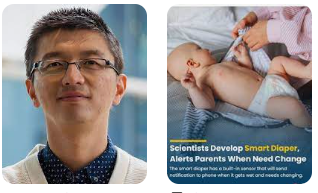Áp dụng công nghệ này cho ghế ở Quốc hội nhé
tã thông minh báo cho bố mẹ khi nào tã bẩn và cần thay...
-----
Not the first smart diaper (tã thông minh) to come along, but consumers seem unready for diapers that can flag urinary tract (đường tiểu, tuyến tiết niệu) infections (nhiễm bẩn) and other biomarkers usually tested by clinical laboratories (thí nghiệm lâm sàng)
Will wonders never cease? For centuries, parents had only their own senses (chỉ dựa vào cảm giác) to determine (quyết định) when infants (trẻ nhỏ) needed diaper changing. Today, however, caregivers can rely on “smart diapers” to send alerts when a diaper is soiled. Crying, smelly babies may no longer be the gold standard in diaper management. But are smart diapers practical?
Scientists at Penn State University in collaboration with scientists from the Hebei University of Technology and Tianjin Tianzhong Yimai Technology Development Company in China think so.
Funded by the National Institutes of Health (NIH) and the National Science Foundation (NSF), Penn State’s new smart diaper is based on a simple pencil-on-paper design that utilizes an electrode sensor array treated with a sodium chloride solution that detects dampness when urine (nước đái) is present.
The sensor array is “so cheap and simple” it “could clear the way for wearable, self-powered health monitors for use not only in ‘smart diapers’ but also to predict major health concerns like cardiac arrest and pneumonia (viêm phổi),”
Bài trước: Khó khăn quá
Tags: parentingtechnology



1 Comments